Thousands of high-voltage electricity pylons to be installed across Britain

National Grid is to install as many as 6,000 electricity pylons across the English countryside as part of plans to invest £31bn in the nation’s transmission networks.
John Pettigrew, chief executive of National Grid, said the 1,000 miles of overhead lines connecting the pylons will prepare the UK for electricity demand which is expected to double over the next 25 years.
Bill payers are to fund the £31bn overhaul of the electricity network as the National Grid “rewires the nation” to hit net zero.
Mr Pettigrew said the infrastructure will also help the nation decarbonise by ditching fossil fuels in favour of electricity from low-carbon sources such as wind farms and nuclear power stations.
National Grid will fund the new pylons partly from charges on households’ annual energy bills, which Mr Pettigrew estimated at “less than £10.” It also plans to raise £6.8bn by issuing one billion new shares to help fund its network expansion, while selling off assets including its Grain liquefied natural gas (LNG) terminal – the largest in Europe.
Mr Pettigrew said: “We’re announcing a transformational step up in our energy infrastructure investment.
“It is at a scale that I think is fair to say is unprecedented, and it will make National Grid one of the biggest investors in the energy transition in the FTSE 100 list of companies.”
National Grid runs the high-voltage electricity transmission network for England and Wales currently comprising 4,400 miles of overhead cable suspended on 22,000 pylons.
Mr Pettigrew said the network was ageing fast and needed to be upgraded, first to cope with the expansion of renewable energy but also because of the predicted surge in demand fuelled by heat pumps, electric vehicles and gigafactories.
He added: “All of that is pushing load up, which is something we’ve not seen on the network for a long time.”
The planned upgrade will result in 2,400 miles of high voltage cables being laid offshore, carrying power along coastlines or from wind farms.
It is planning 1,000 miles of new cable onshore, with another 680 miles of existing overhead lines being “reinforced”, often meaning existing pylons being replaced with larger ones.
Mr Pettigrew said: “This is not just about the network being old and it’s creaking. It’s actually about the fundamentals of what the network’s being asked to do – it’s changing as part of the energy transition.”
The planned upgrade came as National Grid posted a 15pc fall in profits to just over £3bn for the year to March. It also plans to invest a further £29bn in the US, taking its total investment over five years to £60bn – almost double the level over the past five years.
It also plans to sell National Grid Renewables, its US onshore renewables business, to raise cash.
National Grid already has 17 major onshore and offshore transmission projects in the UK and is spending another $4bn (£3.2bn) on its ‘Upstate Upgrade’ in New York’s electricity transmission network.
Recent spending includes the 116 new pylons to connect the new Hinkley Point C nuclear power station when it starts generating sometime after 2028.
Similar expansions are planned in Scotland where the transmission network is managed by different companies. SSE manages networks in northern Scotland, highlands and islands, while SP Energy Networks covers central and southern Scotland.
Separately on Friday, Claire Coutinho, the Energy Secretary, announced plans to cut consumer energy costs, days after Rishi Sunak called a general election for July 4.

Ms Coutinho said she would ask the energy regulator Ofgem to review the future of standing charges on energy bills, fees charged to cover the cost of running transmission and distribution networks.
She also pledged a crackdown on price comparison sites, which she accused of “cowboy practices”.
Other pledges include cutting levies on consumer bills, strengthening the price cap which limits the charges made by suppliers and an obligation for suppliers to repair or replace the two to three million smart meters estimated to have failed over the last decade.
Ms Coutinho said: “Energy bills are at their lowest in two years, now we’re telling suppliers to put consumers first and bring real competition back to the market – cutting bills further and improving customer service.
“Only the Conservatives have a clear plan for a secure future where we reach net zero without punishing families with extra costs.”
Responding to Ms Coutinho’s announcement, a Labour spokesman said: “This is not a plan – this is a call for evidence, a set of options, two consultations, a copy and paste job from an old letter, and lots of wishful thinking.
“The Conservatives will never end the cost of living crisis – only Labour has a plan to cut bills and make Britain energy independent.”

 Yahoo Finance
Yahoo Finance 